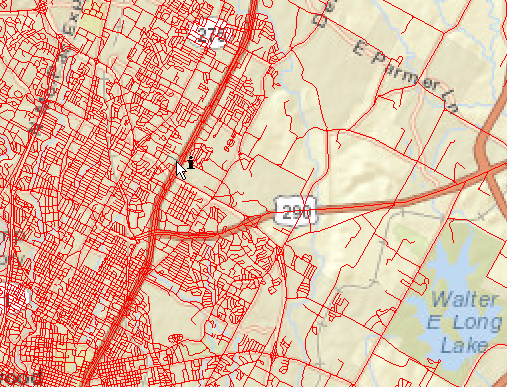Background Maps (Workbench)
You can overlay data that displays in the Visual Preview onto a background map, which allows you to view your data in context.
For example, if you have a dataset that contains roads in a specific city, you can overlay this data1 Background Maps: ArcGIS Online: Sources: Esri, DeLorme, NAVTEQ, USGS, Intermap, iPC, NRCAN, Esri Japan, META, Esri China (Hong Kong), Esri (Thailand), TomTom, 2013 MapQuest: Tiles Courtesy of MapQuest Stamen: Map tiles by Stamen Design, under CC BY 3.0. Data by OpenStreetMap, under CC BY SA. onto a background map of the same area:

When you apply a background map, both the dataset you open and the background map dataset appear together in the View window and the Display Control.
Only features of the dataset you open can be selected for viewing in the Feature Information window or Table View. You cannot zoom in or otherwise change the view of the background map: the focus is always on your own data.
Note: Background map data is reprojected to one of the coordinate systems referenced by the dataset(s) that comprise your view. If you want to reference the coordinate system of the background map when viewing coordinates in the Status Bar, use the drop-down list to select it. For more information, see Changing Coordinate Systems in the Status Bar.
Getting Started with Background Maps
In the Background Maps window under FME Options, you can create and remove background maps. In most cases, however, it is more convenient to create and manage background maps directly in the Visual Preview.
Using Background Maps in the Visual Preview
- Do one of the following:
- If you have not previously added any background maps, right-click on the View node in the Display Control and select Add a background map.
- If you have previously added background maps, right-click on the background map in the Display Control and select Switch to new background map.
The Add Background Map dialog opens.
- Source: Select the background map you want to apply to the view.
- Name: Give the background map a name. Data Inspector saves the background map and all of its settings with this name, so you can reuse it in future views.
- Apply the remaining settings, depending on the Source. For more information, see Background Map Source Settings, below.
- Click Save. The background map appears in the View window and Display Control.
To Add and Use More Background Maps
Right-click on the background map in the Display Control and select Switch to new background map.
To Switch to a Background Map You've Already Created
Right-click on the background map in the Display Control and select it from the context menu.
To Turn Off a Background Map
Right-click on the background map in the Display Control and select Background map off.
To Add, Edit, Duplicate, or Remove Background Maps
Right-click on the background map in the Display Control and select Manage background maps. In the FME Options Background Maps pane, right-click on a background map name and select Edit, Duplicate, or Remove as desired. You can also remove a background map with the (-) button. To add a background map, use the (+) button.
Background Map Source Settings
| Option | Description |
|---|---|
|
Esri ArcGIS Online (AGOL) Map Service |
If you already have an account, enter the account credentials. If you do not have an account, follow the link in the dialog for a free trial of ArcGIS Online. Constraints: Click browse to open a list of available maps (you can filter the list to narrow the choices). Select a map and click OK to accept the selection. The selection displays in the Map List field. |
| HERE WeGo Maps |
|
| Japan GSI Maps | Constraints: Click browse to open a list of available maps (you can filter the list to narrow the choices). Select a map and click OK to accept the selection. The selection displays in the Map List field. |
|
MapBox Web Map Tile Service |
|
|
MapQuest Web Map Tile Service |
|
| Microsoft Bing Maps |
|
|
Stamen Maps |
Constraints: Click browse to open a list of available maps (you can filter the list to narrow the choices). Select a map and click OK to accept the selection. The selection displays in the Map List field. Note: You do not need an account to access Stamen maps. |
| WMS (Web Map Service) |
Specify the URL of the map server you want to access. If the specified server requires authentication, check Use Network Authentication, and specify the authentication method and credentials, if applicable. Specify Constraints, Map Options, Schema Attributes, and Search Envelope parameters as desired. |
|
Others |
Allows you to pick any dataset as a background map. This option is best if you already have data that can be used in this scenario. Select a Format and Dataset to use as the background map. Parameters (Optional) : Specify any format-specific settings that may be relevant to accessing or rendering the data. If you do not change these parameters, in most cases, FME uses default settings. For detailed information on format parameters, click Help on the parameter dialog. Coord. System (Optional): Specify an alternate coordinate system to project the background map. |